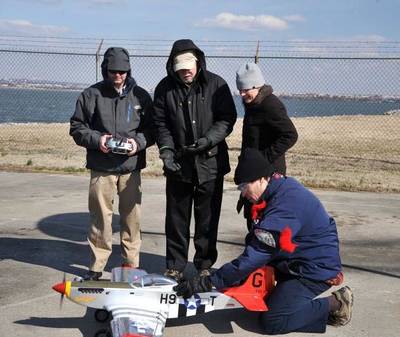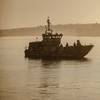The Midas Touch: US Navy Researchers Convert Seawater into Fuel
Researchers at the Naval Research Laboratory (NRL) say they have developed technology to extract carbon dioxide from seawater while simultaneously producing hydrogen, and then converted the gasses into hydrocarbon liquid fuel. NRL engineers consider the breakthrough to be a potentially revolutionary advancement.
Flying a radio-controlled replica of the historic WWII P-51 Mustang red-tail aircraft – of the legendary Tuskegee Airmen – NRL researchers pictured here (l to r) Dr. Jeffrey Baldwin, Dr. Dennis Hardy, Dr. Heather Willauer, and Dr. David Drab (crouched), successfully demonstrate a novel liquid hydrocarbon fuel to power the aircraft's unmodified two-stroke internal combustion engine. The test provides proof-of-concept for an NRL developed process to extract carbon dioxide (CO2) and produce hydrogen gas (H2) from seawater, subsequently catalytically converting the CO2 and H2 into fuel by a gas-to-liquids process.
Using an innovative and proprietary NRL electrolytic cation exchange module (E-CEM), both dissolved and bound CO2 are removed from seawater at 92 percent efficiency by re-equilibrating carbonate and bicarbonate to CO2 and simultaneously producing H2. The gases are then converted to liquid hydrocarbons by a metal catalyst in a reactor system.
"In close collaboration with the Office of Naval Research P38 Naval Reserve program, NRL has developed a game changing technology for extracting, simultaneously, CO2 and H2 from seawater," said Dr. Heather Willauer, NRL research chemist. "This is the first time technology of this nature has been demonstrated with the potential for transition, from the laboratory, to full-scale commercial implementation."
The predicted cost of jet fuel using these technologies is in the range of $3-$6 per gallon, and with sufficient funding and partnerships, this approach could be commercially viable within the next seven to ten years. Pursuing remote land-based options would be the first step towards a future sea-based solution.













